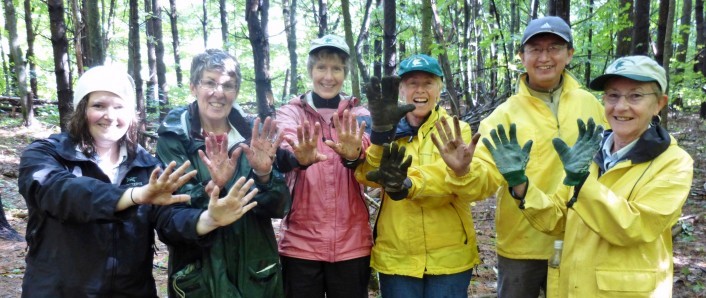Garlic mustard. Purple loosestrife. Phragmites reed. Dog-strangling vine. The list of invading plants keeps getting longer, and our knowledge of how to battle them is ever changing. The species listed here, plus many more, are ones that have shown up in the Couchiching region from their distant home ranges, and they are quickly displacing the native species.
Perhaps it is an absence of leaf-eating predators, or maybe the growing conditions are so much better than its home turf, whatever the reasons, they thrive. As they spread out and establish themselves in local woodlots and pastures, the native plants (and the wildlife that uses them) get crowded out.
The Couchiching Conservancy is actively involved with the stewardship of 44 parcels of land, totally over 12,000 acres. The landscape includes hardwood forests, conifer swamps, cattail marsh, granite outcrops and limestone alvars. This diversity of habitats makes the job of looking after them both exciting and challenging. Exciting as each day can bring a visit to a different habitat than the day before, and challenging as each area has its own mix of invading species.
Garlic mustard, if left unchecked, will eventually disrupt the soil fungus that releases nutrients to tender roots; this disruption can weaken mature trees as well as eliminate trilliums, fawn lilies and spring beauty. As this plant takes two years to mature and drop seeds, there is time to intervene and kill it prior to seed development. But it takes perseverance to actually stop its spread.
The first garlic mustard plant may create 1,000 seeds; some will germinate the next year, others will start their growth anytime over the coming 8-10 years. The gathering of seeds in the soil, year after year, is called the seed bank. To get control over the spread of garlic mustard, the seed bank must be exhausted, which means picking the new growth so that no additional new seeds are ever added. And that’s what we do on our properties, spend time and effort picking bags of young garlic mustard to ensure the health of woodlots under our care.
Property monitoring teams, consisting of volunteers, constantly watch for the arrival of invasive species, and if detected, swing into action. Church Woods, near Shanty Bay, has had garlic mustard pickers out in force for eight years. Elliott Woods, south of Craighurst also has a dedicated team who monitor the forest. And similar with the Helen Butler Reserve, Tushingham Woods, Turnbull Ranch, and Grant Wetlands…wherever there is an invasive plant, there are volunteers on site to remedy the situation.
“Garlic mustard,
if left unchecked,
will eventually disrupt
the soil fungus that releases
nutrients to tender roots;
this disruption can
weaken mature trees as well
as eliminate trilliums,
fawn lilies and spring beauty.”
Some invasive plants have to be dealt with more severely. By sharing information with dozens of other organizations, it has become apparent that the only way to eliminate dog-strangling vine or phragmites reed is by applying a herbicide. The decision to use chemicals on our properties was a difficult one, but to allow these plants to take over the natural habitat is contrary to our mandate to protect these lands for all time.
When spray is used, it is done by those who are trained and licensed. The spray nozzle is set very narrow, ensuring that overspray is reduced to a minimum, and that the chemical is applied to only the targeted plant. The Stewardship Program Manager of the Couchiching Conservancy has now been trained to apply chemicals, such is the serious threat from some invasive species.
Volunteers are always welcome to join our monitoring teams, as there is always room for ‘one more’ to join in to assist with the stewardship of the many properties under our responsibility.
Written by David Hawke, Stewardship Program Manager.


